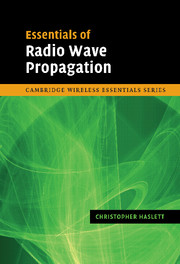Book contents
- Frontmatter
- Contents
- Preface
- Acknowledgements
- 1 Propagation in free space and the aperture antenna
- 2 Point-to-area transmission
- 3 The effect of obstacles
- 4 Reflection, scatter and penetration
- 5 Estimating the received signal strength in complex environments
- 6 Atmospheric effects
- 7 System design and interference management
- 8 Software-based tools
- 9 Summary
- Appendix 1 The decibel scale
- Appendix 2 Phasor arithmetic and phasor diagrams
- Appendix 3 Formula sheet
- Appendix 4 Explanation of the link budget
- Further reading
- References
- Recommendations of the Radiocommunication Bureau of the International Telecommunications Union (ITU), Geneva
- Author's biography
- Index
6 - Atmospheric effects
Published online by Cambridge University Press: 09 August 2009
- Frontmatter
- Contents
- Preface
- Acknowledgements
- 1 Propagation in free space and the aperture antenna
- 2 Point-to-area transmission
- 3 The effect of obstacles
- 4 Reflection, scatter and penetration
- 5 Estimating the received signal strength in complex environments
- 6 Atmospheric effects
- 7 System design and interference management
- 8 Software-based tools
- 9 Summary
- Appendix 1 The decibel scale
- Appendix 2 Phasor arithmetic and phasor diagrams
- Appendix 3 Formula sheet
- Appendix 4 Explanation of the link budget
- Further reading
- References
- Recommendations of the Radiocommunication Bureau of the International Telecommunications Union (ITU), Geneva
- Author's biography
- Index
Summary
Atmospheric effects add significant complicating factors to the job of the radio-system designer. Initially, the way in which multipath propagation can be established due to the atmospheric structure is explained together with the effect this can have on the received signal. Another phenomenon, ducting, whose existence depends upon the structure of the atmosphere, is then discussed. It is seen that ducting can lead to levels of long-distance interference rising. The way in which diversity techniques can reduce the effect of multipath fading is explained. Another form of fading (‘diffraction fading’) is then described. Diffraction fading occurs when the atmosphere causes the path of the radio wave to bend upwards as it travels, leading to no line of sight existing between points for which a clear line of sight would be expected. Next, it is shown that, in severe cases of multipath propagation, the delay between two paths can be significant. This leads to the received spectrum in large-bandwidth links becoming distorted. The amount of fading caused by rain is explained as another factor that must be considered when designing a microwave radio link. Further, the fact that, even if no fading occurs, the ever-present molecules present in the atmosphere will cause attenuation is described, together with an indication of the frequency dependence of this attenuation. Finally, the way in which atmospheric losses affect the noise performance of radio systems, particularly Earth–space systems, is analysed.
- Type
- Chapter
- Information
- Essentials of Radio Wave Propagation , pp. 116 - 149Publisher: Cambridge University PressPrint publication year: 2007



